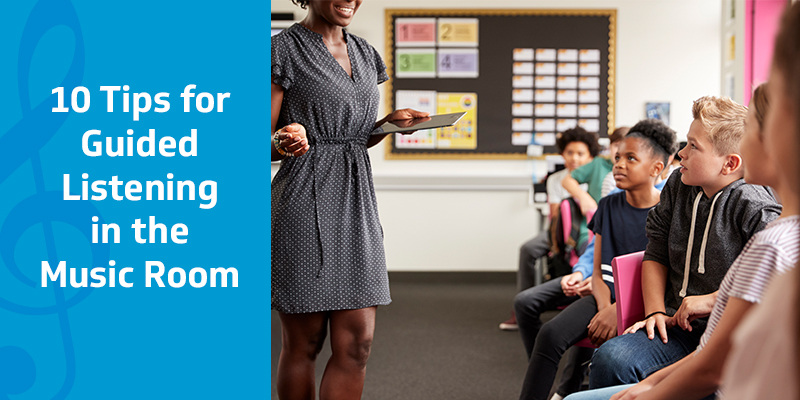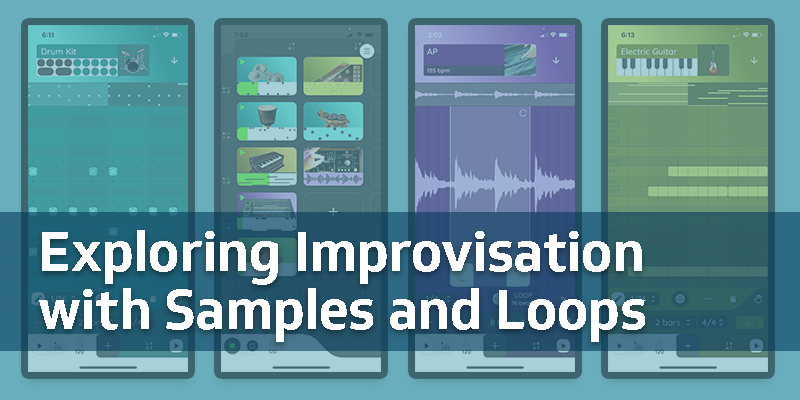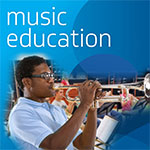Improve aural skills and critical listening

No matter the grade level, music students need to develop critical listening skills as part of their growth as musicians. Whether you’re reviewing new literature before learning it, or introducing students to the great composers and performers in music history, these 10 tips will give you some helpful strategies.
1.) Decide On a Clear Objective Before You Begin
You may already do this as part of your lesson planning, but when it comes to guided listening, making sure you have clearly defined goals in mind is an important first step. It doesn’t have to be complicated, but having a singular focus is helpful.
• Do you want students to listen for a specific instrument or vocal line?
• Are you reinforcing a musical concept like melody, fugue, tempo, dynamics, etc.?
• If you’re introducing a composer, what unique musical devices can they listen for?
• Is there something in the music they can compare/contrast with music that is familiar to them?
• What might be some of the challenges of understanding this piece?
Depending on the age of your students and the nature of the activity, you may want to share the objective with them as well.
2.) Let Students Get Comfy
During guided listening, letting students sit or relax in a different spot than usual sometimes helps them focus on just listening.
• Younger students can lay on the floor, away from friends, or sit with legs outstretched back-to-back with a partner.
• Older students could try sitting backward in chairs so they can rest their arms on the chair back.
• Even designating or assigning special “listening spots” in your room can work to add some novelty to the exercise.
You’re the expert on your students’ behavior, so do what will work best to maintain a quiet classroom while still making the experience unique.
3.) Avoid Always Listening with Videos
We can all agree that it’s much easier to watch a video than it is to listen critically to just auditory content. But when we always provide a visual stimulus, we don’t allow students to develop important aural attention skills. If your objective doesn’t require students to see the performance, consider turning using just the audio for guided listening time. Point out to students that they are “practicing” their listening skills and why those skills are important.
4.) Add an Element of Movement
Younger students especially will benefit from reinforcing concepts and ideas with physical movement. But even middle school and high school students will benefit from the addition of movement to a guided listening lesson.
• Introduce a short excerpt that highlights your objective and assign a physical gesture that students can use when they hear that in the piece. For example – raise your hand when you hear a flute playing, or touch your shoulders if you recognize the melody when it comes in.
• Teach musical form by having students move from one area of the room to another when the theme changes. For example – stand in this corner when you hear the “A” theme, over here for the “B” theme, etc.
• Depending on the piece, have students pantomime being the performers or the conductor. You can ask a small group to “perform” for their class, or have every student choose which instrument they want to be and pretend to play it when they hear it in the piece.
5.) Take the Opportunity to Teach Concert Etiquette
Some students have never attended a live performance, especially in recent years. Treating your guided listening lesson like a “concert” is a great way to make the experience memorable.
• Have tickets and assigned seating, or usher them to their row as they enter the room.
• Flick the lights to let them know the performance is about to begin.
• Act as announcer for the performance and remind them to silence their phones and be courteous
• Introduce the concept of movements within a piece and how to watch the conductor before applauding
• Point out the differences between being an audience member at a concert and being at a sporting event.
6.) Respect the Music
Many teachers use the acronym Super Quiet Uninterrupted Listening Time, or SQUILT to describe guided listening time. However you choose to present it, make sure students know that noise and interruptions diminish the experience for those around them. And make sure you, as the teacher, abide by this rule as well. It’s tempting to sneak in another task when you’ve listened to the same piece for 5 other classes, but model good listening and your students will appreciate it even more.
7.) Include New Musical Vocabulary
While relying on your objective for guidance, see if you can introduce a few new musical terms that relate to the listening piece. Offer students the opportunity to use those new words when sharing feedback about the piece, or when discussing it with their peers. Keep a “word wall” of musical terms that students can refer to in the future.
8.) Return to the Same Pieces Later
Keep a chart of pieces you’ve listened to in your classroom and when you have a few extra minutes, or need an easy sub plan, listen to them again! We all learn best through repetition, and there a few things more delightful than recognizing a melody or motif that you have heard before. Give your students the opportunity to experience that feeling.
9.) Consider the Performers
If possible in your lesson time, include a discussion or introduction to the performers of the piece you’re listening to. Asking questions like, “How did this recording come to be? How long do you think it took to perfect it as individuals, or as an ensemble? How much do you think they had to practice?” Pointing out that professional musicians have to start at the beginning just like young musicians is valuable. There are many parts to creating a professional recording, you could also talk about all the technicians and audio engineers that would have worked on it as well.
10.) Ask Students for Feedback
Giving students time to discuss the piece after listening, or journal about their impressions is a great way to reinforce their learning. Asking questions to get the conversation started is helpful, or begin by asking them to come up with one question they can ask their peers about the piece. For younger students a series of questions in the format of “raise your hand if you heard xyz in the piece” is simpler.
We’ve put together a set of Listening Journal pages that you might find helpful for your classroom guided listening lessons. These are designed for a wide range of ages, since you know your students best and will be able to choose one that they can be successful with. Let us know in the comments if you have used them in your classroom and how it went!






